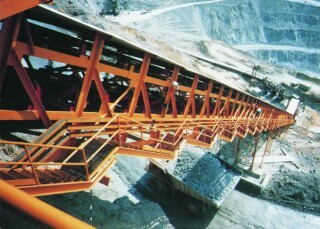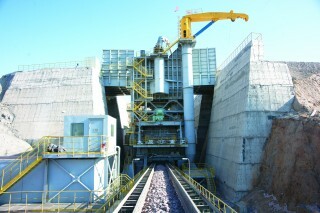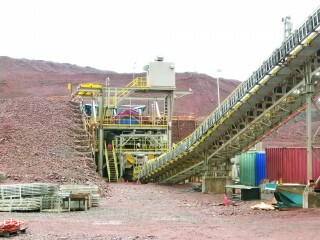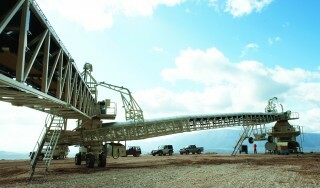The current decline in capital investment in the mining sector alongside exceptionally low commodity and oil prices is challenging the ability of many operations to remain profitable. As a result, mine managers are being tasked to find new ways to reduce their operating costs and avoid potential suspension of operations.
While this slump is to a degree reflected in the current market for in-pit crushing and conveying (IPCC) systems, mining companies are still exploring these options as the technology offers much lower operating costs than conventional truck haulage, as well as significant savings over the life of mine.
Independent operations in particular may not have the financial backing to wait for commodity prices to return to sustainable levels, and many are investigating IPCC systems as a means of returning to profitability. Subsequently, vendors such as Joy Global are seeing requests for more modest pilot systems to prove the economics of IPCC and provide the operational experience that gives operators the data and confidence to make bigger investments.
Sandvik, another market leader in this segment, reports that while actual IPCC investments, like all capital projects across the mining industry, have fallen off, the studying and planning of these systems continues unabated.
The company continues to deliver desktop studies, analysing and comparing IPCC with truck-and-shovel haulage. It states that of the 150+ studies it has completed to date, IPCC was the rated choice in over 80% of the cases. However, the issue remains that few are comfortable with ‘processing' material inside the pit, and even fewer understand the substantial mindset changes required to make an IPCC system perform well.
Karl Ingmarsson, product-line manager for IPCC at Sandvik, says: "Short-term tactics to limit investment have slowed the growth of IPCC, but don't confuse this with long-term strategies to be low-cost leaders.
"The industry is painfully aware that traditional truck haulage is not the answer when ore grades are generally declining and stripping ratios increasing. IPCC is one long-term solution to a long-term problem."
"Investors grew wary of large CAPEX projects in the last boom cycle," Michael Viet, president of Sandvik Mining Systems, tells MM. He adds that "a key to success for IPCC is to deliver on time and within budget. As an OEM, we mitigate investment risks by understanding the application, using proven designs and minimising the number of parties involved."
Truck haulage is the largest contributor to in-pit mining costs and is an obvious area to look at reducing. However, it is each company's individual evaluation of its financial and market circumstances that determines if it will actually implement IPCC.
FLSmidth explains that one mining company may view an IPCC system as essential to maintain profitability as the pricing forecast for its commodity decreases. Without an IPCC system to lower overall OPEX, the mine could be forced to close.
Another may view IPCC as a way to increase profitability over its existing truck/shovel operation. However, it may be unwilling to make such a large capital investment with uncertain market conditions and will simply try to weather the storm at a lower profit rate. In short, there is no single way to evaluate how mining companies will view an IPCC system.
Fellow Scandinavian Metso reports that in addition to lower operating costs, mines also see significant safety benefits by reducing the use of trucks at their operations.
"Mining engineers are recognising that IPCC opens the opportunity to design pit shells and mine plans which can increase the value of a resource," says Veikko Kuosa, bid manager for IPCC solutions at Metso. "Drivers such as these together with the long-term trends in decreasing grades and deeper resources are highlighting the long-term benefits of IPCC solutions."
ThyssenKrupp states that while some of the larger mining markets, especially those dominated by coal and iron ore, have currently stalled when it comes to capital investments regardless of the type of systems involved, other markets such as copper and phosphate still seem to be active.
"However, even if current CAPEX spending has slowed down dramatically, we still see high interest in an efficiency and productivity increase on the customer side," explains Thomas Jabs, head of the company's resource technologies unit - mining systems. "Short-term and long-term, IPCC is always part of our discussions for process optimisation."
New products and R&D
One factor that has challenged the uptake of fully mobile IPCC systems in the past has been conveyor technology. The traditional shiftable conveyor can only be moved laterally or at very shallow angles, and this has limited the use of fully-mobile systems to strip-type pits. Fully mobile conveyors following the crusher are one solution, but this can be costly for large operations.
Conveying out of deep pits at high capacities has historically been an issue but new belt technology has now made this possible. Joy Global has supplied over 140 of its High Angle Conveyors (HAC) and the company recently developed a new fabric belt that makes it possible for a single HAC to move 8,000t/h with lifts of 200m at a 45° angle. Multiple HACs operating in parallel or series can be used when more capacity or lift is required.
With semi-mobile IPCC systems, the general strategy is to relocate the crusher to keep it as near to the excavation as possible and minimise truck-haul distance, but the cost to relocate structures with extensive civil works can be prohibitive. Joy Global has supplied feeder breakers that utilise an earthworks hopper. These require minimal civil works and can be relocated by dragging with a dozer.

The company has also been looking at the compatibility of its IPCC systems with loading tools and believes that the performance of the entire system can be significantly improved through shovel selection.
In 2014, Joy Global released the P&H 4800XPC electric mining shovel with a 122.5t working payload. Preliminary engineering is also complete on a long-range version, the 4800XPC LR, with the same digging capacity as the 4100XPC but with longer dipper handles and a taller boom.
The taller boom allows the mine to use taller benches, which can decrease the number required overall. Using fewer benches reduces the cost of the conveyor equipment required to follow the mobile crusher, and in a typical mine plan the 4800XPC LR can dig 38% more material before relocating the crusher.
Additionally, the taller boom increases the clearance from the dipper door to the top of a hopper. The longer dipper handles reduce the precision required when positioning the shovel to dump into the hopper of the mobile crusher. In this example, Joy Global states that the whole system's annual productivity could increase 7% due to fewer crusher relocations and conveyor shifts.
Metso, meanwhile, has been working on its crushers. The new Lokotrack LT130E and Lokotrack LT150E mobile jaw-crusher models are now available matched with Lokolink mobile conveying systems. These machines feature Metso's heavy-duty Nordberg C130 and C150 jaw crushers that replace the previous C125 and C140 models.
Metso has also developed high-capacity, semi-mobile crushing solutions for IPCC applications with primary gyratory crushers

and Nordberg C-series jaw crushers. The company has been focusing particularly on safety and easy access for maintenance.
FLSmidth's latest IPCC product is the Dual Truck Mobile Sizer (DTMS). With two different models based on 214t and 363t trucks, the highly mobile, truck-fed crushing station requires no foundations and only minimal site preparation. The company says it has seen a high level of interest in this technology from mines worldwide.
FLSmidth also now offers dozer traps with production rates up to 6,000t/h. These products are complementary to its Buffalo reclaim feeders and can be used where production rates or abrasiveness of material are less than ideal for a reclaim feeder.
Going forward, one particular focus for IPCC-related products is improved mobility and flexibility. The idea of using mobile crushing stations is to periodically advance them along with the mining face; the truck haul distance, or cycle time, should be kept to a minimum. However, some semi-mobile stations have proved too large, heavy or costly for regular relocations.
Sandvik has been working to increase the mobility of its crushing stations and add greater flexibility as to the type of feed each design can handle. The company states that the requirements of an IPCC system may change during the life of mine - experience shows that geology tends to vary more than thought in the original mine design - and crushing stations should be flexible enough to handle a variety of material, from sticky clay to hard or brittle rocks, and accommodate truck as well as shovel feed. "This is an evolving field based on advanced materials technology, flow simulations, control and monitoring systems, and hands-on product support," the company adds.
Intelligent operation
Safety, remote health monitoring and autonomous operation go hand in hand, and every company interviewed for this article mentioned that they are focusing R&D efforts on at least one of these areas.
Remote health monitoring is integral to a successful IPCC system as availability and utilisation are of utmost importance. However, just collecting terabytes of data will not improve reliability.
Joy Global says its systems use advanced technology and prognostics to anticipate service needs, optimise machine productivity and improve mine performance. "We are continuously improving the data analysis algorithm and expanding the scope of these systems," the company states.
Joy Global is also developing and field-testing products that will improve the situational awareness of the shovel operator to improve dump accuracy, reduce clean-up costs and help lead to increased operator safety.
Metso is focused on reducing energy consumption, and improving safety and environmental performance through greater automation, tele-operation and remote condition monitoring. The company has developed its ICr system, which allows an excavator operator to remotely control a Lokotrack mobile crushing plant. It says that this makes the operation safer and more convenient, and crusher operating data can then be sent via satellite for remote reporting and diagnostics.
Sandvik is also supporting efforts to develop mine-planning software. The company says that all existing software has evolved around truck-and-shovel mining, making it challenging to practically plan an IPCC mine.

A particularly interesting area to watch will be the marriage of autonomous trucks with IPCC systems. The technology is ideal for guiding trucks autonomously to the bridge at the crusher. The shorter haul reduces the size of the truck fleet, but it also reduces the area that needs to be secured or closed to other traffic.
Technically, the biggest challenge is to manage autonomous trucks on the dump, as the edge constantly moves and is not always stable. Autonomous trucks and IPCC should be seen as supplementary technologies, not competing.
What's holding IPCC back?
Ask any expert which factors are limiting the uptake of IPCC systems in mining and you are likely to get a myriad of answers that range from "there are no technical limits" to "operator knowledge and perception" and "investors pushing for lowest-CAPEX options".
Everyone has their own opinion on this topic and there is no right or wrong answer. The truth is that, even though IPCC can offer significant benefits in the right situation, it's a combination of factors that is preventing the concept from going mainstream.
Investors in greenfield and expansion projects do often seek to minimise their exposure by choosing the lowest-CAPEX options, sometimes to the detriment of the long-term return. Traditionally, this approach penalises IPCC over conventional truck-and-shovel solutions. However, some OEMs such as Metso are able to offer lifecycle services that minimise initial CAPEX under long-term, performance-based, capital-inclusive contracts. Metso states that this value proposition has proved a win-win situation for both itself and mine operators.
Sandvik has identified and publicly discussed what it believes to be "the top 10" biggest challenges facing IPCC in the past. It says that of these, lack of knowledge among mining engineers may be the single biggest hurdle; IPCC is still not taught in any regular mining university curriculum.
To address this, Sandvik has worked with the University of Queensland in Australia to develop a training programme. One focus area is to explain the various types of IPCC, including mobile systems that work together with trucks and can be located anywhere.
"We must overcome the perception that it has to be massive greenfield deposits," says Viet, "when IPCC is just about utilising inexpensive conveying as much as possible."
Another major hurdle is the perception that IPCC is inflexible. Mining engineers are been taught to always mine the next best ore and delay waste removal as long as possible. As a continuous process, IPCC can deliver high capacity and low OPEX, but "you cannot design and operate an IPCC mine wearing truck-and-shovel goggles", explains Ingmarsson, "and you need to utilise production capacity following your own plan".
Certain existing IPCC systems have not achieved the production rates or cost savings that were originally anticipated. This can be due to a number of circumstances including improper implementation, misidentified or changing material properties and incorrect system design. However, FLSmidth points out that there is no single or group of consistent factors that may limit the installation or success of an IPCC system, and as vendors continue to gain experience from previous installations, these factors will become less relevant.
Success stories
Despite the challenges involved, there are many IPCC systems operating successfully around the globe and this number is growing rapidly.
An IPCC system delivered to the Altay Polimetally copper mine in Kazakhstan in late 2013 has proven a flagship project for Metso. It includes an MAF210 mobile apron feeder and Lokotrack LT200E mobile jaw crusher with a Lokolink LL16 mobile conveying system and MS16 mobile stacker. The fully mobile plant is in the last phase of commissioning and has a nominal capacity of 2,500t/h.
Metso has also delivered a fully mobile IPCC system to BHP Billiton's Samarco iron-ore mine in Brazil. The customer ordered two Lokotrack LT140E mobile jaw crushers with a Lokolink conveying system and has now begun operating two similar systems with the capacity to process 2,300t/h each.

Sandvik Mining recently delivered a PX200 ‘relocatable' crushing system to Tata Steel Minerals Canada's direct shipping ore (DSO) project in Newfoundland and Labrador, Canada. The brownfield site, which closed in 1982 is now reopening using new technologies. The stripping ratio is about 1:1 and the ore is a soft and sticky haematite. At least two open pits will be mined simultaneously for the same processing facility.
Sandvik's delivery includes a CR810/12-20 primary hybrid crusher feeding a CR810/08-30 secondary crusher with an adjoining transfer conveyor. Sandvik tells MM that quality and reliability is critical, as 100% of the feed passes through these machines. The complete system has been designed using low-temperature steel.
"It is good foresight of the client to choose a primary station that is relocatable," says Ingmarsson. "As these pits progress, there are possibilities to optimise the truck-haul distance."
Hot commissioning took place in August last year and full production is scheduled for later this year. The system is designed for 28,000t/d operating on a 24/7 basis.
"The hybrid crusher has proven itself in everything from hard metallic ore to overburden and limestone," adds Heiko Kertscher, product line manager for roll crushers at Sandvik, "and we are excited to add another reference specifically in iron ore."
After the commissioning of its first fully mobile, crawler-mounted crushing plant in China nearly seven years ago, ThyssenKrupp now has four fully mobile IPCC systems at the Baiyinhua coal mine. As of 2014, a complete continuous crushing system for overburden removal supplied by ThyssenKrupp has been operating successfully in Brazil (the system centres around two fully mobile crushing plants), and the company has numerous contracts for semi-mobile crushing systems under way for clients in Chile and Peru.
























